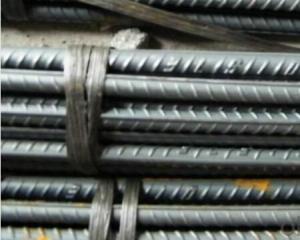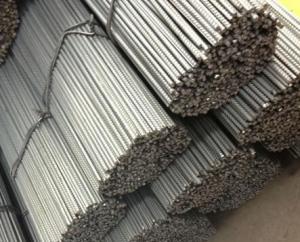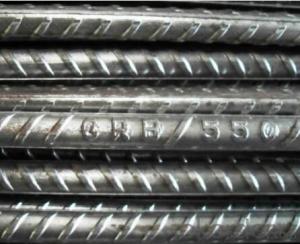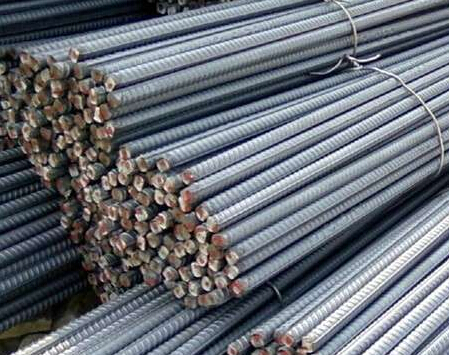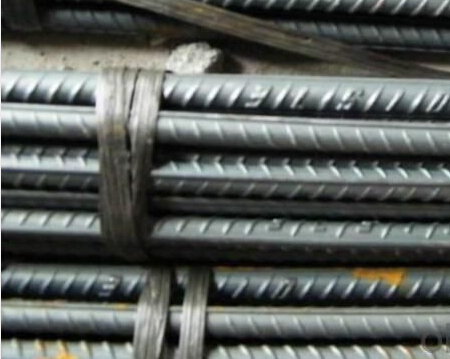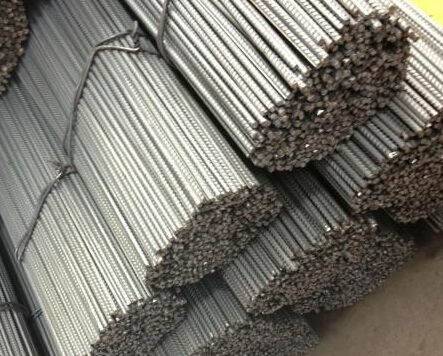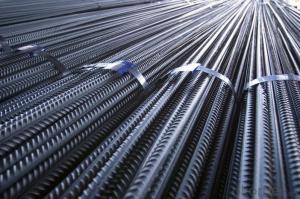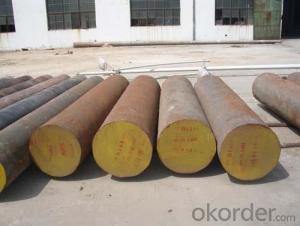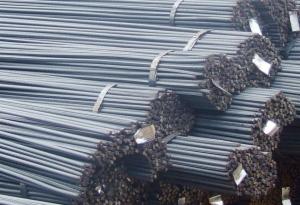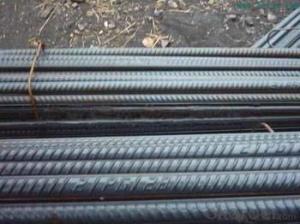Deformed Steel Rebars with High-Quality and Standard GB,UK,USA
- Loading Port:
- China Main Port
- Payment Terms:
- TT or LC
- Min Order Qty:
- -
- Supply Capability:
- -
OKorder Service Pledge
OKorder Financial Service
You Might Also Like
Product Description:
OKorder is offering Deformed Steel Rebars with High-Quality and Standard GB,UK,USA with Standard GB,UK,USA at great prices with worldwide shipping. Our supplier is a world-class manufacturer of steel, with our products utilized the world over. OKorder annually supplies products to European, North American and Asian markets. We provide quotations within 24 hours of receiving an inquiry and guarantee competitive prices.
Product Applications:
Deformed Steel Rebars with High-Quality and Standard GB,UK,USA are ideal for structural applications and are widely used in the construction of buildings and bridges, and the manufacturing, petrochemical, and transportation industries.
Product Advantages:
OKorder's Deformed Steel Rebars with High-Quality and Standard GB,UK,USA are durable, strong, and resist corrosion.
Main Product Features:
· Premium quality
· Prompt delivery & seaworthy packing (30 days after receiving deposit)
· Corrosion resistance
· Can be recycled and reused
· Mill test certification
· Professional Service
· Competitive pricing
Specifications of High-Quality Deformed Steel Rebars with Standard GB,UK,USA:
Standard | GB UK USA | HRB335 HRB400 HRB500 G460B, B500A, B500B,B500C GR40, GR60 | |
Diameter | 6mm,8mm,10mm,12mm,14mm,16mm,18mm,20mm, 22mm,25mm,28mm,32mm,36mm,40mm,50mm | ||
Length | 6M, 9M,12M or as required | ||
Packing | Export standard packing: wrapped by wire rod in bundles | ||
Each bundle weight | 2-3MT, or as required | ||
Trade terms | FOB, CFR, CIF | ||
Payment terms | TT payment in advance or Irrevocable LC at sight. | ||
Delivery Detail | within 45 days after received advanced payment or LC. | ||
Brand name | DRAGON | ||
Theoretical weight and section area of each diameter as below for your information:
Diameter(mm) | Section area (mm²) | Mass(kg/m) | Weight of 12m (kg) | Pcs/ton |
6 | 28.27 | 0.222 | 2.664 | 375.38 |
8 | 50.27 | 0.395 | 4.74 | 210.97 |
10 | 78.54 | 0.617 | 7.404 | 135.06 |
12 | 113.1 | 0.888 | 10.656 | 93.84 |
14 | 153.9 | 1.21 | 14.52 | 68.87 |
16 | 201.1 | 1.58 | 18.96 | 52.74 |
18 | 254.5 | 2.00 | 24 | 41.67 |
20 | 314.2 | 2.47 | 29.64 | 33.74 |
22 | 380.1 | 2.98 | 35.76 | 27.96 |
25 | 490.9 | 3.85 | 46.2 | 21.65 |
28 | 615.8 | 4.83 | 57.96 | 17.25 |
32 | 804.2 | 6.31 | 75.72 | 13.21 |
36 | 1018 | 7.99 | 98.88 | 10.43 |
40 | 1257 | 9.87 | 118.44 | 8.44 |
50 | 1964 | 15.42 | 185.04 | 5.40 |
Chemical Composition: (Please kindly find our chemistry of our material based on JIS as below for your information)
JISG3112 SD390 | Chemical Composition | ||||
C | Mn | Si | S | P | |
0.22 | 1.38 | 0.4 | 0.014 | 0.022 | |
Physical capability | |||||
Yield Strength(N/cm²) | Tensile Strength(N/cm²) | Elongation (%) | |||
620 | ≥400 | 21 | |||
The production process of High-Quality Deformed Steel Rebars with Standard GB,UK,USA
1-Waling beam furnace 2-Roughing rolling group 3-Intermediate rolling train
4-Finishing rolling group 5-Water-cooling device 6-Walking beam cooler
7-Finishing equipment(including the cold scale shear,short feet collection system,
automatic counting device,bundling machine, collect bench)
Usage and Applications of High Quality Deformed Steel Rebars:
Deformed bar is widely used in buildings, bridges, roads and other engineering construction. Big to highways, railways, bridges, culverts, tunnels, public facilities such as flood control, dam, small to housing construction, beam, column, wall and the foundation of the plate, deformed bar is an integral structure material. With the development of world economy and the vigorous development of infrastructure construction, real estate, the demand for deformed bar will be larger and larger..
Packaging & Delivery of High Quality Deformed Steel Rebars:
Packaging Detail: products are packed in bundle and then shipped by container or bulk vessel, deformed bar is usually naked strapping delivery, when storing, please pay attention to moisture proof. The performance of rust will produce adverse effect.
Price: Keep lower operating costs so as to offer competitive price for our clients
Note:
1. Our products are produced according to national standard (GB), if not, supply according to national standards (GB) or agreement as customer required.
2. Other Grade and Standard Deformed Steel Bar we can supply:
Grade: GR40/GR60, G460B/B500A/B500B/B500C,BST500S
Standard: ASTM, BS, DIN
The Minimum Order Quantity of these products is high, and need to be confirmed.
3. We can not only supply Deformed Steel Bar; if you need anything about building materials, please contact us for further information.
4. Please send us your detail specifications when inquire. We will reply to you as soon as possible. We sincerely hope we can establish a long stable business relationship.
FAQ:
Q1: Why buy Materials & Equipment from OKorder.com?
A1: All products offered byOKorder.com are carefully selected from China's most reliable manufacturing enterprises. Through its ISO certifications, OKorder.com adheres to the highest standards and a commitment to supply chain safety and customer satisfaction.
Q2: How do we guarantee the quality of our products?
A2: We have established an advanced quality management system which conducts strict quality tests at every step, from raw materials to the final product. At the same time, we provide extensive follow-up service assurances as required.
Q3: How soon can we receive the product after purchase?
A3: Within three days of placing an order, we will begin production. The specific shipping date is dependent upon international and government factors, but is typically 7 to 10 workdays.
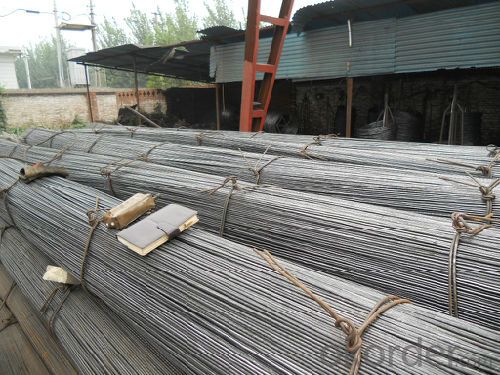
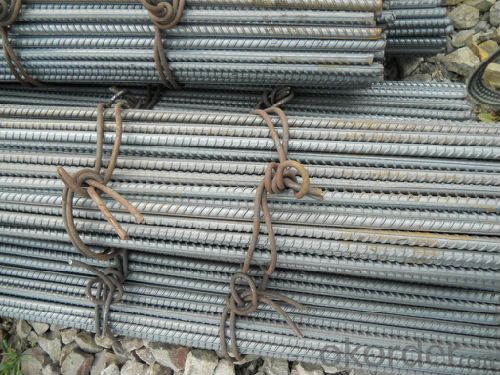
- Q: Can the thread steel of the steel platform of the fixed unloading platform not work?
- Construction of steel tubular scaffold safety technical specifications JGJ 1302011 provisions:The diameter of U shaped reinforcing bar or anchor bolt of section steel for anchorage platform shall not be less than 18mm., and U shaped bars, bolts or bolts used for anchoring shall be made by cold bending and HPB300 grade steel bars shall be used. U - shaped steel bar, anchor bolt and steel gap shall be steel wedge or hardwood wedge.
- Q: Are there any limitations to using steel rebars in construction?
- Using steel rebars in construction has its limitations. For one, they can corrode when exposed to moisture and oxygen, especially in high humidity or coastal areas where saltwater can speed up corrosion. This corrosion weakens the structure over time, necessitating regular maintenance and inspections to prevent structural failure. Another limitation is their high thermal conductivity, which means they conduct heat and cold more easily than other materials. This can lead to increased energy transfer and potentially impact the overall energy efficiency of the building. Moreover, steel rebars are heavy and require specialized equipment for handling and installation. This raises construction costs and may restrict their use in applications where weight is a concern, such as high-rise buildings or areas with weak soil conditions. Further, steel rebars are vulnerable to electromagnetic interference, which can be problematic in buildings with sensitive electronic equipment or areas with high levels of electromagnetic radiation. Lastly, steel rebars are not environmentally friendly. Their production contributes to carbon dioxide emissions, and they have a high embodied energy, requiring a significant amount of energy for manufacturing and transportation. In conclusion, while steel rebars are widely utilized in construction for their strength and durability, it is crucial to consider these limitations and evaluate whether alternative materials or construction methods would be more appropriate for specific projects.
- Q: What's the difference between primary and two grade steel and three grade steel?
- There are two levels of steel rebar, three steel, four steel grade difference, no grade steel, there are a lot of customers to wire (round) mistakenly called a steel. At present, China is gradually out of grade two steel, four steel grade two steel grade HRB335, three grade steel grade HRB400, four grade of steel wire is HRB500, (Pan Yuan) new material grades are HPB195, HPB235, HPB300, old wire material grades corresponding is Q195, Q235.
- Q: How do steel rebars affect the overall acoustic properties of a structure?
- Steel rebars, also known as reinforcement bars, play a significant role in the overall acoustic properties of a structure. The presence of steel rebars can have both positive and negative effects on the acoustic characteristics of a building or infrastructure. One of the primary ways steel rebars affect the acoustic properties is through their ability to transmit sound vibrations. Steel is a good conductor of sound, meaning that it can easily transmit sound waves. Therefore, when steel rebars are present in a structure, they can act as pathways for the transmission of sound, allowing it to travel more easily throughout the building. This can lead to increased noise levels and reduced acoustic privacy, as sound waves can travel through the steel rebars and reach different parts of the structure. On the other hand, steel rebars can also contribute to the overall sound insulation of a structure. When properly installed and integrated with other construction materials, such as concrete or acoustic insulation materials, steel rebars can help reduce the transmission of sound waves. The rigidity and mass of steel rebars can help dampen the vibrations caused by sound waves, thereby reducing the amount of sound that passes through the structure. This can enhance the acoustic comfort within the building, making it quieter and more suitable for various activities that require reduced noise levels. It is worth noting that the impact of steel rebars on the acoustic properties of a structure depends on various factors, such as the thickness and density of the surrounding construction materials, the arrangement and spacing of the rebars, and the overall design of the building. Additionally, the use of additional acoustic treatments, such as sound-absorbing panels or insulation, can further improve the acoustic performance of a structure by mitigating the negative effects of steel rebars. In conclusion, steel rebars have a significant influence on the overall acoustic properties of a structure. While they can facilitate the transmission of sound waves, they can also contribute to sound insulation when combined with appropriate construction materials and techniques. Proper design and implementation, along with the use of additional acoustic treatments, are crucial in achieving a desired acoustic environment in buildings and infrastructure where steel rebars are present.
- Q: How do steel rebars prevent concrete structures from spalling?
- The reinforcement and increased strength provided by steel rebars prevent spalling in concrete structures. Spalling occurs when the concrete surface cracks and breaks off due to internal pressure from factors like temperature changes, moisture, or structural loads. When steel rebars are embedded in the concrete, they act as a support system that evenly distributes applied loads throughout the structure. This prevents localized stress concentrations, which can cause spalling, by absorbing and dissipating the load. By reinforcing the concrete, rebars enhance its ability to withstand external forces and improve its tensile strength. Furthermore, steel rebars help control crack formation in the concrete. Concrete is a brittle material with low tensile strength, making it prone to cracking under stress. However, rebars hinder crack propagation by bridging them and transferring the stress to the surrounding concrete. This prevents the cracks from spreading and results in a more durable and resilient structure. Additionally, steel rebars protect against corrosion. Concrete's natural alkalinity forms a protective layer on the steel surface, preventing rusting. This alkaline environment acts as a barrier against corrosion, ensuring the rebars maintain their structural integrity over time. By avoiding corrosion, the rebars can continue to reinforce the concrete and prevent spalling. In conclusion, steel rebars are essential in preventing spalling in concrete structures by providing reinforcement, improving tensile strength, controlling crack formation, and protecting against corrosion. They enhance the stability and durability of the concrete, allowing it to withstand external pressures and maintain its integrity for an extended period.
- Q: How are steel rebars protected against corrosion?
- Steel rebars are protected against corrosion through a process called corrosion protection. This involves applying a protective coating or using corrosion-resistant materials such as stainless steel or epoxy-coated rebars. Additionally, rebars can be embedded in concrete, which acts as a barrier against moisture and oxygen, further preventing corrosion. Regular inspections and maintenance are also important to ensure the long-term protection of steel rebars against corrosion.
- Q: Are steel rebars subject to any international standards or regulations?
- Yes, steel rebars are subject to international standards and regulations. The most widely recognized international standard for steel rebars is the ISO 6935-2 standard, which sets requirements for the chemical composition, mechanical properties, and dimensions of rebars. Additionally, various countries have their own national standards and regulations that ensure the quality and safety of steel rebars used in construction projects.
- Q: Can steel rebars be used in highway barrier construction?
- Yes, steel rebars can be used in highway barrier construction. They are commonly used as reinforcement in concrete barriers to enhance their strength and durability.
- Q: Are there any environmental concerns associated with steel rebar production?
- Yes, there are several environmental concerns associated with steel rebar production. Firstly, the extraction and processing of iron ore, which is used to produce steel, can lead to deforestation, habitat destruction, and soil erosion. Additionally, the production process emits significant amounts of greenhouse gases, contributing to climate change. Steel rebar production also requires large amounts of water, leading to potential water scarcity issues. Furthermore, the disposal of waste materials and byproducts from steel production can contaminate soil and water bodies, posing risks to ecosystems and human health. Therefore, it is important to consider and address these environmental concerns in the steel rebar production process.
- Q: Are steel rebars resistant to earthquakes?
- Yes, steel rebars are highly resistant to earthquakes. The use of steel rebars in reinforced concrete structures significantly enhances their structural integrity and helps to withstand the forces generated during an earthquake. The high tensile strength and ductility of steel rebars allow them to absorb and distribute seismic forces, minimizing the risk of structural failure.
Send your message to us
Deformed Steel Rebars with High-Quality and Standard GB,UK,USA
- Loading Port:
- China Main Port
- Payment Terms:
- TT or LC
- Min Order Qty:
- -
- Supply Capability:
- -
OKorder Service Pledge
OKorder Financial Service
Similar products
Hot products
Hot Searches
Related keywords

